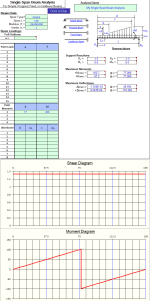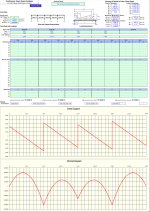Enhanced BEAMANAL

Description
Acknowledgement:
This Excel Workbook is based on the Excel Workbook "BEAMANAL.xls" by Alex Tomanovich, P.E.
Purpose:
Structural analysis of a single-span or continuous-span beam requires determination of the internal loading distribution based on external loads and beam supports. This workbook provides the calculations necessary for determination of the internal loading distribution (shear and moment distribution) along with the slope and deflection distribution. The Workbook by Mr. Tomanovich is mainly for steel structures in the Civil Engineering world. I am in Aerospace and deal in inches and millimeters rather than feet. Therfore, I have tried to make the calculations unit free.
Program Description:
This Workbook provides for the analysis of either single-span or two (2) to five (5) continuous-spans analysis a beam with loadings including point loads, point moments, constant distributed and linearly variable loadings. Four (4) end constaint cases for the single-span beam, and fixed or simple support at ends of the two (2) through (5) span, continuous-span beam, are considered. Specifically, beam end reactions as well as the maximum moments and deflections are calculated. Plots of both the shear and moment diagrams are produced, as well as a tabulation of the shear, moment, slope, and deflection for the beam or each individual span.
This Excel Workbook consists of four (4) Worksheets, described as follows:
Doc - This documentation sheet
Single-Span Beam - Single-span beam analysis for simple, propped, fixed, & cantilever beams
Continuous-Span Beam - Continuous-span beam analysis for 2 through 5 span beams
Reference - Formulas and Methods used in the calculations
Program Assumptions and Limitations:
1. The following reference was used in the development of this program (see below):
"Modern Formulas for Statics and Dynamics, A Stress-and-Strain Approach" by Walter D. Pilkey and Pin Yu Chang, McGraw-Hill Book Company (1978), pages 11 to 21.
2. This Workbook uses the three (3) following assumptions as a basis for analysis:
a. Beams must be of constant cross section (E and I are constant for entire span length).
b. Deflections must not significantly alter the geometry of the problem.
c. Stress must remain within the "elastic" region.
3. On the beam or each individual span, this Workbook will handle a full length uniform load and up to eight (8) partial uniform, triangular, or trapezoidal loads, up to fifteen (15) point loads, and up to four (4) applied moments.
4. For single-span beams, this Workbook always only allows a particular orientation for two (2) of the the four (4)
different types. Specifically, the fixed end of either a "propped" or "cantilever" beam is always assumed to be on
the right end of the beam.
5. This Workbook will calculate the beam end vertical reactions and moment reactions (if applicable), the maximum positive moment and negative moment (if applicable), and the maximum negative deflection and positive deflection (if applicable). The calculated values for the end reactions and maximum moments and deflections are determined from dividing the beam into fifty (50) equal segments with fifty-one (51) points, and including all of the point load and applied moment locations as well. (Note: the actual point of maximum moment occurs where the shear = 0, or passes through zero, while the actual point of maximum deflection is where the slope = 0.)
6. Calculations for two (2) specific locations from the left end of the beam for the shear, moment, slope, and deflection is available.
7. The plots of the shear and moment diagrams as well as the displayed tabulation of shear, moment, slope, and deflection are based on the beam (or each individual span) being divided up into fifty (50) equal segments with fifty-one (51) points.
8. For continuous-span beam of from two (2) through five (5) spans, this program utilizes the "Three-Moment Equation Theory" and solves a system simultaneous equations to determine the support moments.
9. This Workbook contains numerous “comment boxes” which contain a wide variety of information including explanations of input or output items, equations used, data tables, etc. (Note: presence of a “comment box” is denoted by a “red triangle” in the upper right-hand corner of a cell. Merely move the mouse pointer to the desired cell to view the contents of that particular "comment box".)
Units
| System 1 | System 2 | System 3 | |||
| Length | inches | feet | millimeters (mm) | ||
| Force | pounds | kips (kilo-pounds) | Newtons (N) | ||
| Moment | inch-pounds | ft-kips | N-mm | ||
| Distributed | pounds/inch | kips/ft | N/mm | ||
| E | pounds/inch^2 (psi) | kips/in^2 (ksi) | MegaPascals (MPa) | ||
| I | inch^4 | inch^4 | mm^4 | ||
| R | pounds | kips | N | ||
| M | inch-pounds | ft-kips | N-mm | ||
| D | inches | inches/1728 | mm |
Calculation Reference
Beam Analysis
Structural Design
Stiffness Methods
Calculation Preview
Full download access to any calculation is available to users with a paid or awarded subscription (XLC Pro).
Subscriptions are free to contributors to the site, alternatively they can be purchased.
Click here for information on subscriptions.




Also, on the Reference sheet added the Microsoft Equation 3 formula object for V and M to go with theta and delta, but that is just show the formulas in a more readable form.